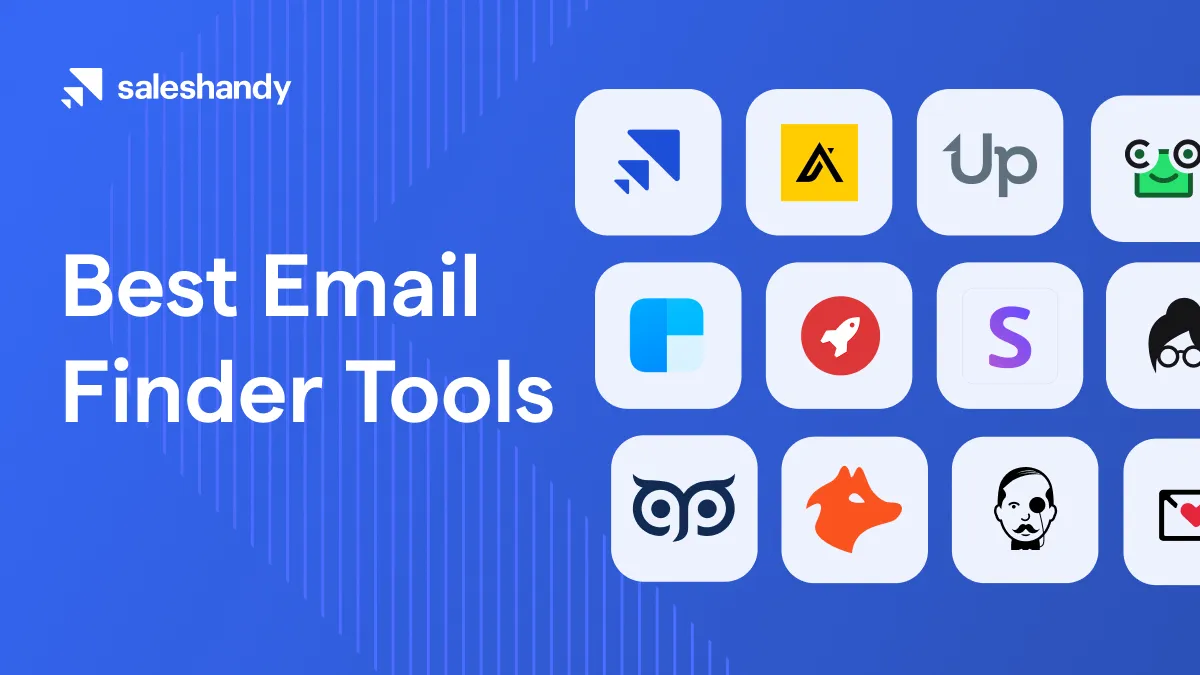Contents
- 1 Outbound Lead Generation – Table of Contents
- 2 What is outbound lead generation?
- 3 How does outbound lead generation work?
- 4 Outbound vs inbound lead generation
- 5 Outbound lead generation strategies
- 6 Why is cold emailing the best outbound lead generation strategy?
- 7 How to run a successful cold email campaign in 7 simple steps
- 8 Concluding thoughts
- 9 FAQs
Outbound lead generation is a powerful method to boost your sales. In fact, it is even considered one of the most effective methods for businesses to acquire quality leads.
But here’s the thing – outbound lead generation is quite difficult to master. On the bright side, it does have the potential to speed up lead generation . So it’s definitely worth mastering.
So how can you generate high-quality outbound leads at scale?
In this blog, we have shared a list of outbound strategies that you can implement to increase your oubound lead generation results.
Outbound Lead Generation – Table of Contents
- What is outbound lead generation?
- How does outbound lead generation work?
- Outbound vs inbound lead generation
- Outbound lead generation strategies
- Why is cold emailing the best outbound lead generation strategy?
- How to run a successful cold email campaign in 7 simple steps?
- Concluding thoughts
- FAQs
What is outbound lead generation?
Outbound lead generation involves reaching out to prospective customers who may not be aware of your product, with the aim of generating interest and establishing a sales pipeline.
This approach employs sales representatives who proactively initiate communication through various methods such as cold calling, cold emailing, social selling, etc.
When you implement focused outreach and advertising strategies, you can effectively show how your business can benefit your potential customers.
Primarily, your outbound strategy should answer these questions clearly:
- What unique value proposition are you offering to them or their business?
- What reasons would compel them to engage in a conversation with you or consider purchasing your product?
Answering these two simple questions can give a treasure of insights you need to optimize your outbound lead generation strategy.
That said, now that you know what outbound lead generation means, let us see how the entire process works.
How does outbound lead generation work?
Outbound lead generation involves a series of steps that begins with identifying your target audience and ends with ultimately converting them into paying customers.

Here is an overview of the general outbound lead generation process:
- Step 1: Identify leads based on your Ideal Customer Profile (ICP) established by your sales and marketing teams. Research the pain points of these leads and determine how your product or service can provide a solution.
- Step 2: Obtain contact information from reliable sources like email databases, LinkedIn email finder tools, etc. Organize the extracted information into segmented lists.
- Step 3: Choose your preferred outreach channels to reach your target audience. Here, you have to be mindful of the preferences of your audience and select the channels that are most likely to yield responses.
- Step 4: Initiate outreach efforts and qualify leads based on their response. This is the stage where you can engage with potential customers and assess their interests.
- Step 5: Once you’ve generated interest, the next step is to schedule meetings, demos, or consultations. You can provide more in-depth information and show the value of your offerings.
- Step 6: After contact and meetings, make sure you continue nurturing leads through follow-up communication, providing additional information, and addressing any remaining concerns. Guide them through the sales process to convert them into paying customers.
By following these steps and continuously improving your strategy, you can generate leads and drive sales.
Now that we know the whats and hows of outbound lead generation, you might wonder how it is different from inbound lead generation.
Outbound vs inbound lead generation
There are several distinctions between inbound and outbound lead generation.
The primary distinguishing factor lies in their marketing approaches: inbound lead generation employs pull marketing, whereas outbound lead generation relies on push marketing.
Here is a table that briefly explains the key differences between the two types of lead generation techniques.
| Inbound Lead Generation | Outbound Lead Generation | |
|---|---|---|
| Approach | Inbound lead generation aims to attract prospects organically and encourages them to initiate contact with your business. | Outbound lead generation involves actively reaching out to prospects to deliver your message and promote your products or services. |
| Prospect Action | Inbound lead generation relies on prospects taking the initiative to reach out to you. They may visit your website, request more information, seek a product demo, or make a purchase. | Outbound lead generation involves businesses reaching out to prospects through various channels such as advertising, direct mail, phone calls, emails, and other methods. The goal is to proactively initiate contact with potential customers. |
| Methods | Inbound lead generation strategies focus on content marketing, search engine optimization (SEO), social media engagement, infographics, and other techniques that drive traffic to your website. | Outbound lead generation employs advertising campaigns, targeted email or phone outreach, direct mailers, and other direct promotional methods. |
| Permission | Inbound lead generation often requires prospects to give their permission or consent for further engagement. | Outbound lead generation typically initiates contact without explicit consent. |
| Marketing Type | It respects the prospect’s control over the interaction and focuses on building relationships based on consent and trust. | Its aim is to capture attention and generate leads, even if it interrupts the prospect’s current activities. |
Given these differences, it’s clear that outbound lead generation must not be neglected.
Below, we’ve shared the best outbound lead generation strategies to help you get a jumpstart.
Outbound lead generation strategies
- Cold emailing
- Cold calling
- LinkedIn cold outreach
- Social selling
- Multi-channel outreach
- Pay-per-click (PPC)
- Referral marketing
- Content syndication
Cold emailing
Cold emailing involves sending an unsolicited email to introduce your brand to a potential lead who doesn’t have any previous connection or relationship with you or your business.
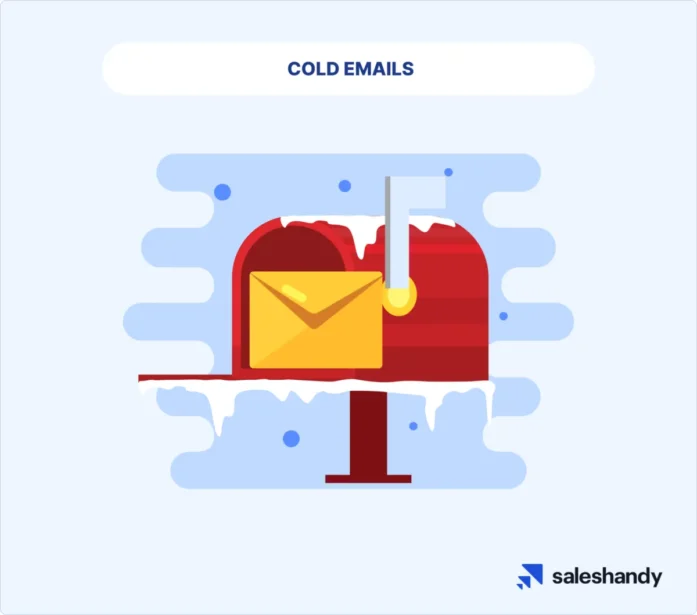
The aim is to initiate contact and begin building a relationship in order to promote your product or service. This method is both cost-effective and highly scalable for outbound lead generation.
Cold emails provide recipients with ample time to familiarize themselves with your product and carefully consider their options before reaching a decision.
While sending cold emails, research to identify the best time to send emails, and always prioritize engagement and foster conversations rather than solely focusing on sales pitches.
When you present your product or service, emphasize the benefits it offers rather than just listing its features.
The best part? – You can automate the entire cold email outreach process with Saleshandy!
For the uninitiated, Saleshandy is a lead cold email software that lets you personalize your cold emails at scale, automate the entire follow-up email sequence, and generate high-quality outbound leads easily.
LinkedIn cold outreach
LinkedIn cold outreach is a valuable strategy for outbound lead generation. It allows you to connect with potential prospects who match your target audience and personalize your messages to address their needs.
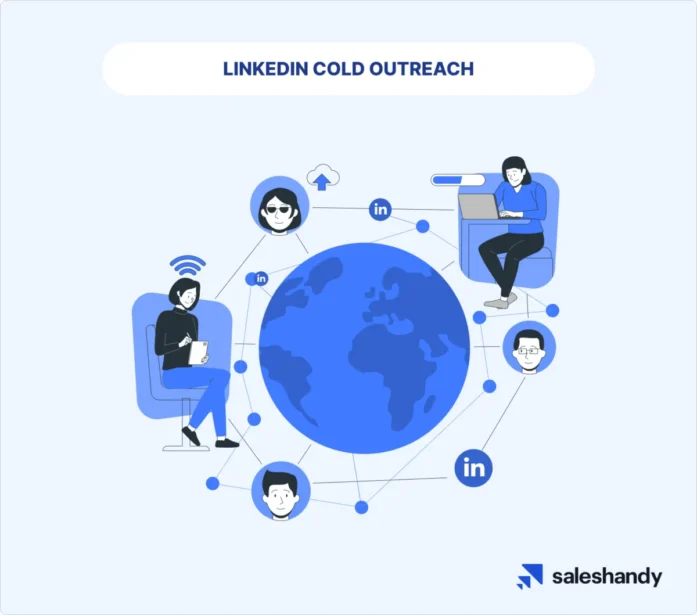
The platform also enables relationship-building through personalized communication. Additionally, LinkedIn provides analytics to track the performance of your outreach campaigns, allowing you to optimize your lead generation efforts.
And with Saleshandy Connect, you can easily find verified email addresses of your prospects from their LinkedIn profiles and reach out to them outside the platform.
This, in turn, greatly increases the chances of prospect engagement and generate leads via email communication.
In summary, LinkedIn cold outreach helps you connect with prospects, build credibility, foster relationships, and track your results.
Also read: 30 Best Outbound Sales Software to Close More Deals
Cold calling
Cold calling involves reaching out to prospective customers who have not previously interacted with the salesperson by making a phone call.
Cold calling provides a personal touch, allowing sales development representatives (SDRs) to gain valuable insights from each call.
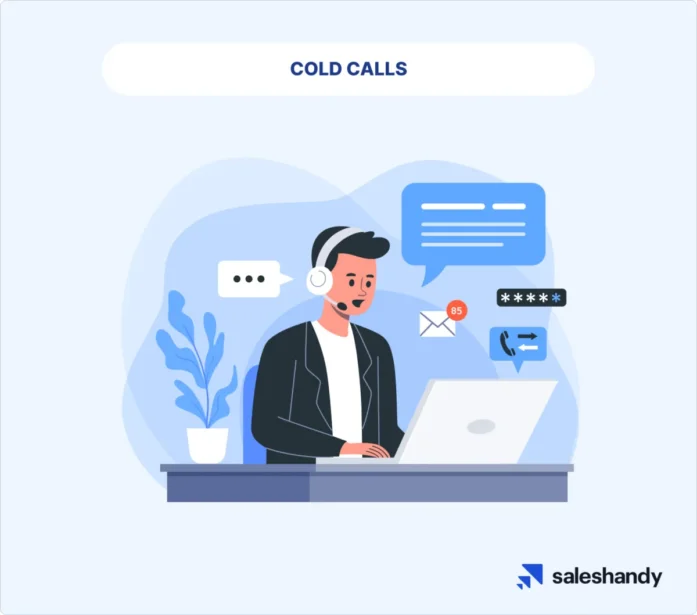
To execute cold calling effectively, you must research the optimal times to make calls and be skilled in presenting the company’s product or service.
Through cold calls, you can reach a broad audience, exposing your brand to a wide range of potential sales. Moreover, it provides you with distinct advantages in terms of closing sales and gathering valuable feedback.
Read more: Cold Email vs Cold Call: Which is More Effective
Social selling
Social selling involves leveraging your brand’s social media channels to establish connections with prospects, foster relationships, and engage potential leads.
This approach can significantly help you achieve sales targets. When you engage in social selling, you can expand the reach of your brand to a larger audience of potential buyers.

Among various social media platforms, LinkedIn is the most business-oriented platform and the ideal choice for conducting social selling activities. While other platforms like Facebook, Instagram, and TikTok can be used to build brand presence and create targeted advertisements, LinkedIn provides the best outreach opportunities.
Multi-channel outreach
Multi-channel outreach involves using various sales channels to connect with potential customers, establish relationships, and generate leads.
The primary purpose of this outbound strategy is to increase the likelihood of successfully engaging with a prospect by contacting them on multiple channels & platforms.
In case your prospects are busy and happen to miss your message on one channel, they can engage with you on different channels.
When you reach out to decision-makers through various channels, they are more likely to trust that your intention is to provide genuine value, as long as you maintain consistency and avoid sending multiple conflicting messages.
Running multi-channel outreach campaigns offers numerous benefits. But you have begun slowly and focus on perfecting each channel.
Pay-per-click (PPC)
PPC, or pay-per-click, is a digital marketing approach where you have to pay a fee for each click on your ads. In simple terms, you are only charged for your advertising when someone actually clicks on your ad.
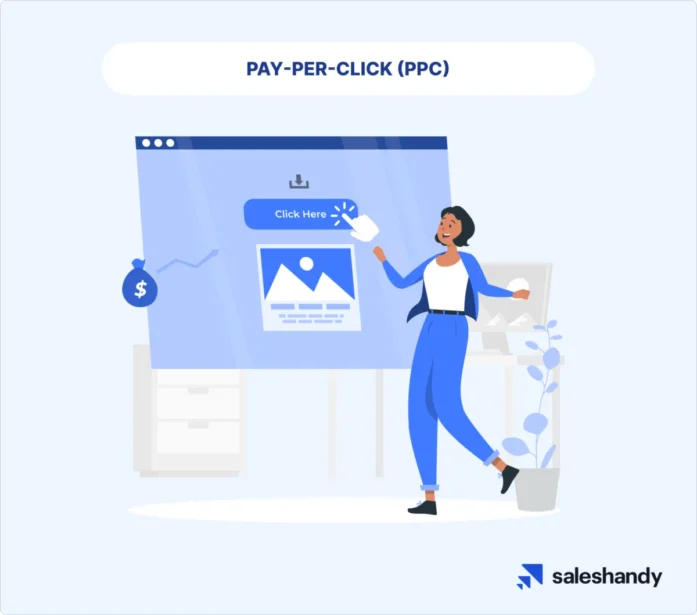
You have to create ads and participate in online auctions by bidding on specific search phrases. This will allow you to showcase your ads on the search engine results page.
While some lead sources generate organic leads, PPC is a more expensive form of lead generation that requires management by a performance team.
Each click on an ad in PPC advertising requires you to make a payment. These costs can accumulate rapidly, especially when bidding on highly competitive keywords.
Referral marketing
Referral marketing is a powerful strategy for outbound lead generation. It leverages word-of-mouth recommendations from satisfied customers, partners, and industry connections.
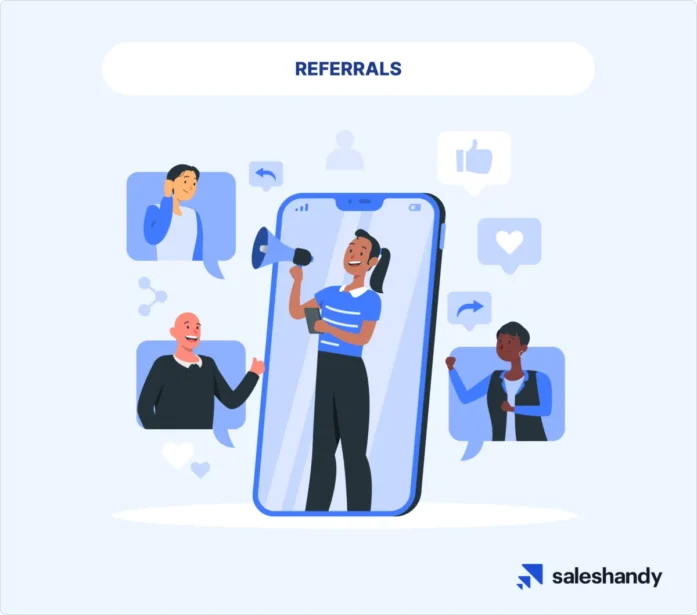
Furthermore, referral marketing increases brand awareness by exposing your business to new audiences. It taps into existing networks, targeting individuals who align with your target audience.
More importantly, Referred customers are more loyal and have higher retention rates, increasing their lifetime value.
As a result, referral marketing helps to generate high-quality leads, boosts brand awareness, taps into networks, and fosters customer loyalty, which positively impacts your lead generation outcomes.
Content syndication
Content syndication involves the republishing of your own content on other websites. By syndicating your content, you expand its reach and introduce it to new audiences, ultimately driving more traffic back to your own site.
Content syndication amplifies your reach and boosts traffic to your website. You can syndicate digital content in various forms, such as blog posts, articles, infographics, videos, and more. It operates as a barter arrangement where the third-party website receives valuable, relevant content at no cost.
Email and online communities like Facebook and LinkedIn groups, forums, and Subreddits serve as effective channels for content distribution.
These are some of the best outbound strategies that you can employ for lead generation.
But let’s be honest here – you cannot do everything all at once. You have to stick to one or two strategies that works for you best.
But which one should you choose from the list?
It can be overwhelming to choose the right approach that will give you the best results.
Based on Hubspot’s report, an overwhelming 80% of prospects have clearly indicated a preference for communication through email compared to other outreach channels.
This underscores the fact that when it comes to reaching out to prospects, cold emailing is undoubtedly the most effective approach.
But how? Let’s discuss.
Why is cold emailing the best outbound lead generation strategy?
Among all other outbound strategies, cold email lead generation emerges as a front-runner because of its cost-effectiveness, personalization, and scalability.
Let’s see how.
- Cost-effective approach: Firstly, it stands out as one of the most budget-friendly tactics available. With its low cost, it provides an opportunity for businesses of all sizes to engage with potential customers effectively.
- High ROI: Cold email outreach boasts one of the highest returns on investment in the market, reaching an impressive up to 4200%. This means that businesses can expect significant gains by leveraging this strategy.
- Scalability and automation: Additionally, it offers scalability and automation options, even within a limited budget. This flexibility allows businesses to reach a wider audience without straining their resources.
- Email personalization: By tailoring messages to individual recipients, businesses can generate more valuable leads and enjoy higher response rates. This, in turn, can lead to increased revenue and better overall outcomes.
Notably, cold email outreach distinguishes itself from intrusive cold calls. When executed skillfully with a personalized touch, you can avoid coming across as pushy and respecting the recipient’s boundaries.
Above all, the ultimate aim of cold email outreach is to foster strong relationships with prospects. By understanding their specific needs and preferences, you can deliver the value necessary to convert them into loyal customers.
Now that we know why cold emailing stands above other outbound lead generation strategies, you might wonder which cold email software is the best.
How to run a successful cold email campaign in 7 simple steps
Running a successful cold email campaign is quite difficult. But it doesn’t have to be.
With Saleshandy, you can automate the entire cold email outreach process.
Let’s check out the step-by-step process to run a successful cold email campaign using Saleshandy.
Step 1 – Create a Saleshandy Account
First of all, visit Saleshandy website and create a new account.
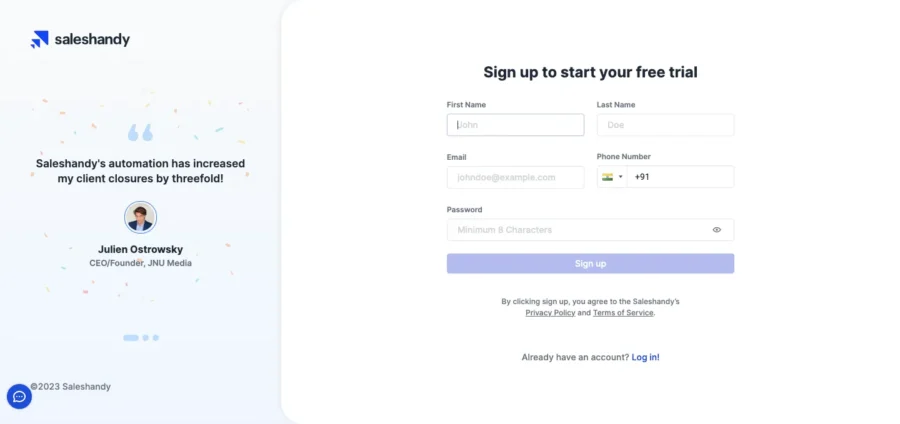
Step 2 – Connect your email accounts
After creating a Saleshandy account, connect the email accounts you want to use for cold email campaigns.
To connect your email accounts, go to ‘Settings’, click on ‘Email Accounts’ from the left-side menu, and tap on the ‘Add Email Account’ button as shown in the screenshot below.

Note: You can connect up to 50 different email accounts in Saleshandy.
Using multiple email accounts is highly recommended as it helps to maintain high email deliverability.
For example, if you want to send 50 cold emails in a day, consider adding up to five email accounts from one domain.
Step 3 – Upload your prospects list
Once you’ve connected your email accounts, it’s time to upload your prospects list.
Click on the ‘Prospects’ link from the left-side menu, click on the ‘Add Prospect’ button, and select your CSV file as shown below.

When you click on the ‘Upload’ button, Saleshandy will automatically verify email addresses of your prospects.
This will help to ensure that your emails successfully reach the intended inbox.
Step 4 -Write your email copy
The success of any cold email campaign heavily relies on a well-written and personalized email copy.
So, draft an email copy that instantly grabs your prospect’s attention, right from the subject line, and keep your email body clear & to the point.
Most importantly, make sure to personalize your email to make it more human and less like a mass marketing message.
Saleshandy has plenty of email personalization features such as merge tags, spintax, and so on to hyper-personalize your emails at scale.

Alternatively, you can also consider utilizing Saleshandy’s email templates to save time and ensure consistency across your email communication.
Step 5 – Set automated follow up sequence
Once you’ve written your email and created an initial template, you can set up a sequence of follow-up emails that gets sent automatically if there is no response from the prospect within a specified period.

When writing your follow-up emails, remember to tweak the content of each email to keep it fresh and relevant.
Additionally, use Saleshandy’s email scheduling feature to find best time to send emails based on when your emails are typically opened and/or responded to.
Step 6 -Send a test email
Before going live with your campaign, it’s important to test your emails to ensure they appear as you intended.
With Saleshandy, you can send test emails to yourself or your team members.

Specifically, check for things:
- How your subject line appears in the inbox.
- Whether your personalized fields are populating correctly.
- If any links are working properly.
- How your email looks on different devices.
Step 7 – Activate the sequence
After testing and refining your emails, it’s time to activate your campaign.
With Saleshandy, launching your campaign is as easy as a click of a button.

So, once you’re confident with your email copy and follow-up sequence, simply select your recipients, schedule the start time, and activate your sequence.
Saleshandy will then manage the rest, automatically sending your emails and follow-ups at the scheduled times.
That said, if you’re still having second thoughts, here are a few reasons to choose Saleshandy for cold email outreach campaigns:
- Streamlined automation: With the ability to automate repetitive tasks like follow-ups and scheduling, you can ensure consistency and efficiency throughout your sales activities.
- Personalized outreach: By sending personalized emails to multiple recipients simultaneously, you’ll experience higher open and response rates, leading to more closed deals and increased revenue.
- Unified inbox: The unified inbox feature allows you to organize your emails, track opens and clicks, and stay on top of follow-ups, all within a single, streamlined interface.
- Cost-effectiveness: Regardless of the volume of emails you send, the cost remains consistent, making it an ideal choice for those seeking an effective sales automation tool while maintaining budgetary constraints.
- Insightful analytics: By tracking email opens, clicks, and responses, you can refine your outreach strategy and improve conversion rates based on data-driven decisions.
With such a comprehensive set of features, Saleshandy addresses your common pain points and offers a holistic solution that elevates your sales efforts to new heights.
Watch the following video to learn how to generate high-quality leads through cold emailing:
Concluding thoughts
To significantly boost your sales revenue, you have to enhance your sales process. And relying solely on inbound lead generation may not be enough to generate leads.
By adopting outbound lead generation strategies, you can proactively establish your presence and capture the attention of your target audience. Moreover, outbound marketing, more specifically cold emailing, allows you to engage with potential leads and effectively filter qualified prospects.
You can choose any of the outbound lead generation strategies to expand your business and enhance your sales mentioned above.
If you are seeking an outbound cold emailing tools software to automate your cold emails and strengthen your outreach efforts, Saleshandy can be your partner.
FAQs
1. What is an outbound strategy to generate leads?
Outbound lead generation involves some way of contacting prospects directly, whether it’s through phone calls, direct mail, emails, or social channels like LinkedIn. It involves employees speaking directly to decision-makers on behalf of your business.
2. What are the 4 L’s of a lead generation strategy?
The 4 L’a of lead generation are lead capture, landing pages, lead magnets, and lead scoring.
3. What is an example of an outbound lead generation?
Two examples of outbound leads are 1) A marketing qualified lead (MQL) who has shown interest in your product through your website or via social engagement and 2) a sales qualified lead (SQL) who has been picked up by one of your sales representatives.
4. How do you automate outbound lead generation?
Here are the key steps to automate outbound lead generation
- Data collection and segmentation
- Email automation
- Workflow automation
- Integrate with CRM
- Personalization and customization
- Analytics and optimization



